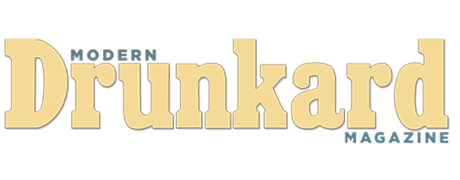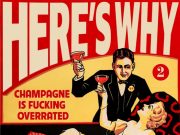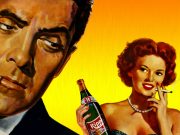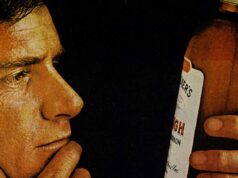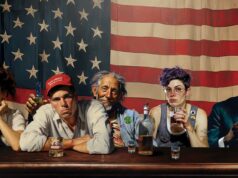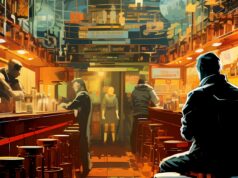 AUGUST 6 1945: Less than an hour after an atom bomb flattened Hiroshima, the nattily-attired barmen of the Washington Press Club began shaking up a gin, Pernod and vermouth concoction they called the Atomic Cocktail.
AUGUST 6 1945: Less than an hour after an atom bomb flattened Hiroshima, the nattily-attired barmen of the Washington Press Club began shaking up a gin, Pernod and vermouth concoction they called the Atomic Cocktail.
It went for 60 cents a pour and the press boys lapped them up with glee. And why not? It was a heady time — the arrival of the long-rumored atomic bomb not only spelled the end of that long goddamn war, it cemented America’s number-one ranking on the world stage. We might not have been the only superpower, but we sure as hell wielded the biggest stick, a stick that scared the hell out of everyone, even those hulking Soviets.
What’s more, the government and media swore we were giddily teetering on the brink of a fabulous new age, an Atomic Age. Soon this fantastic genie in a bottle would serve up cheap and abundant power, not to mention a vast spectrum of technological advances. Why, it wouldn’t be long before the average Joe wouldn’t have to lift a finger — atomic-powered machines would do all the work, whether that be growing crops, fighting wars or pouring rounds of celebratory cocktails.
Oh sure, there were a few doom-and-gloomers fretting about what might happen should the genie run amok or end up in the hands of the wrong sort of people, but those shrills were plainly communist agitators. And even if this atomic genie was a terrible monster, it was, for the time, our monster and ours alone.
America embraced its new, reportedly obedient slave with open arms. Atomic-themed motels, bars and sundry other businesses sprung up across the land; popular magazines splashed their covers with tantalizing images of atomic-powered cars, aircraft and homes, all of which seemed to be waiting in the wings, ready to spring out at any possible moment. The kids especially thought the atomic meme keen: when Kix cereal offered a Lone Ranger Atom Bomb Ring in 1947, they were overwhelmed with over two million orders.
Soon there was hardly a bar in the land that didn’t offer some manner of Atomic Cocktail. The recipes varied radically — sometimes they were served in test tubes, sometimes they were set aflame — but the premise was the same. They were a high-proof celebration of what would surely be a fantastic new future. (It should also be noted that the new word “fallout” came to describe the hangovers inflicted by these powerful potations.)
At home Americans poured cocktails from shakers shaped like atomic missiles, much as Vikings once swilled mead from the skulls of conquered chieftains. Swizzle sticks featured mushroom clouds, glassware sparkled with that ubiquitous atomic symbol and cocktail napkins encouraged the next round with “Up and Atom!” and “Let’s Get (Atom) Bombed!”
Not everyone, of course, awaited this new era with relish: philosopher Robert M. Hutchins suggested that the easy living promised by atomic energy might give rise to terminal boredom: “The leisure of the atomic age will create a peace more horrible than war. After we have read all the comic books, travelled all the miles, seen all the movies, drunk all the liquor we can stand, what shall we do then?”
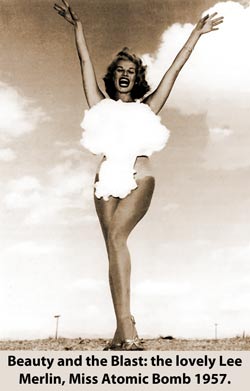 The Genie Gets Loose
The Genie Gets Loose
Then those copy-cat commies got their evil hands on the bomb and that boundless optimism about all things atomic suddenly transformed into a brooding dread.
We, of course, could be trusted with the atom’s awesome power, but those godless Reds, well, they were a different story altogether. A 1956 newspaper editorial noted that the Russkies were probably drunk most of the time and “one day may be so sodden with vodka, that instead of simply insulting the ambassadors of the free nations by boasting ‘We will bury you,’ they will give the order for the burial itself.”
This new threat seemed very real, and why wouldn’t it? In 1953 those sadistic eggheads running the Doomsday Clock — who were atomic scientists, for crissakes — swore that it was two freaking minutes until midnight, with midnight being nothing less than global thermonuclear war.
The suddenly well-funded Office of Civil Defense (OCD) tried mightily to prepare the startled citizenry for the nuclear attack that was surely coming. They cranked out wave after wave of booklets and films, including the classic Bert the Turtle cartoon. This was a time when yelling “Duck and cover!” on a crowded city street would cause half the pedestrians to lurch mechanically to the ground, cover their necks and wait for the white-hot rush of radioactive blast.
The government did its level best to assure us that, if properly prepared, we would not only survive an atomic strike, but thrive. One film even went so far as to suggest that your bloodline might well benefit from a jolt of radiation. Hell, maybe your descendents would mutate into telepaths or shape-shifters, practically guaranteeing them a plum job in the post-apocalpyse economy.
 Eat, Drink and Be Merry, For Tomorrow We Atomize
Eat, Drink and Be Merry, For Tomorrow We Atomize
It wasn’t long, of course, before psychiatrists and politicians began fretting that this keen and constant sense of impending doom might well spur a loosening of morals and irresponsible behavior. Like heavy drinking.
Sen. Glen H. Taylor (D-ID) opined that “If people live in fear of the bomb, if a man knows when he goes to bed at night he may not wake up in the morning, why he may decide to go out and get drunk.”
“The thud of people dropping off the wagon is heard all round the bars,” wrote popular columnist and noted drunkard Robert C. Ruark. “The sudden and rather complete extinction has assumed the aspect of faddism.”
The usual worries, like staying on your diet, making your mortgage payments or finding a job were pushed aside by the imminence of societal destruction. Every day above ground seemed a gift that could be reasonably celebrated with a drink. Or a lot of drinks.
“Why fret over a lousy liver if the word ‘live’ might shortly be removed from the organ,” noted Ruark. “Make the Martinis drier, Charlie, there may be a juniper shortage underground.”
Then arrived a British study suggesting alcohol reduced the effects of radiation on the human body. The thing was, the alcohol had to be in your bloodstream when the bomb hit, and since nobody knew when it was going to hit, the only sensible thing was to have a protective level of booze in your system at all times.
Fear of the bomb also lent a load of momentum to the already burgeoning Tiki bar craze. There was something very attractive about walking into a primitive world uncomplicated by technology, especially the sort of technology that could transform your city into a radioactive crater. A popular song of the day, “Civilization,” performed by Danny Kaye and the Andrew Sisters, describes a native refusing to leave his simple life in the Congo because civilization has “things like the atom bomb, so I think I’ll stay where I am.”
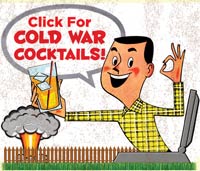 The Fatalists: Obliteration Before Radiation
The Fatalists: Obliteration Before Radiation
A growing group of fatalists cast aside Bert the Turtle’s advice to duck and cover and chose instead to duck into the nearest dive and await obliteration from atop a bar stool.
“None of us will have to worry because we’ll all be blown to bits the first day. So cheer up, huh?” So said the bartender in the Oscar-winning film The Best Years of Our Lives.
One cynical columnist went so far as to suggest all the money spent on public shelters would be better spent on “a gigantic barbecue with free booze and belly dancers for all.”
This apathy toward surviving a nuclear holocaust was further evidenced in the lackadaisical attitude which generally greeted the practice evacuations occasionally organized by the OCD. When the sirens blared, the bars, not the highways, tended to fill up. Instead of jumping in their cars and getting caught in the world’s worst rush hour, many citizens chose to huddle in dim dives and take their chances amongst the bottles.
Others complained that even if civil defense was effective, the wrong sort of people might survive doomsday. Rep. Martha Griffith (D-MI) went on record saying that due to the downtown locations of most public shelters “if the bomb fell at night, you would save nobody but skid row characters, drunks, a few people in hospitals and maybe the night shift on the local newspapers.”
He Who Lasts, Laughs: Boozing in the Bomb Shelter
Of course, not everyone felt that the post-apocalyptic life was not worth living. Displaying that deeply ingrained pioneer spirit, many Americans meant to survive whatever horror and hardship might be coming their way.
This gang didn’t put much faith in the public shelters. First, there wasn’t enough of them to house the multitudes and, worse, they had silly rules against bringing in vital neccesities, like booze. They weren’t keen on hunkering down with a mob of edgy strangers with nothing to live on but canned water and OCD crackers (which you’d need to eat about 45 a day to maintain normal caloric levels).
When 26 volunteers spent a weekend in a government fallout shelter in 1961, one participant said, surely with no small amount of horror, that the ordeal “was like being at a cocktail party without the booze.”
 In 1967, in the biggest fallout shelter experiment conducted up to then, 750 volunteers filed into a public shelter with just what they could carry. When a reporter inquired as to the possible infiltration of liquor, the OCD spokesman shrugged, saying, “We didn’t frisk them. That will depend on their leaders and how they handle this. Who knows what possessions, in event of nuclear attack, a person would grab to take with him?”
In 1967, in the biggest fallout shelter experiment conducted up to then, 750 volunteers filed into a public shelter with just what they could carry. When a reporter inquired as to the possible infiltration of liquor, the OCD spokesman shrugged, saying, “We didn’t frisk them. That will depend on their leaders and how they handle this. Who knows what possessions, in event of nuclear attack, a person would grab to take with him?”
Indeed. While it wasn’t revealed how much booze made it into the shelter, it obviously wasn’t enough: after the two-day experiment was over, one crew-cut lad remarked the first thing he’d do was get a beer, and maybe a bath.
When they realized they’d never get adequate funding to build enough public shelters, the OCD shifted the burden of survival to the individual citizen, announcing: “Each person and family must be prepared to meet immediate survival requirements for two weeks following an attack without dependence on outside assistance.”
There were many advantages to having your own shelter, they said, hinting you could bring items that would not be allowed in public shelters, like pets and alcohol.
Many took this advice to heart, building fallout shelters in their basements and backyards. The OCD provided stock lists which, as you might imagine, did not include beer, wine or liquor. Tranquilizers, sleeping pills and coffee, yes, but booze? No dice.
The list did mention “articles of comfort,” however, and we all know what that means. You can bet the average sheltee laid in a supply of liquor. And why wouldn’t they? After the destruction of civilization, when would a drink be more needed and appropriate? Food and water might sustain the body, but what of the soul, the spirit of man? You’d be jittery enough without a pot of government-approved coffee coursing through your veins; what you’d want was a soothing pour of Scotch.
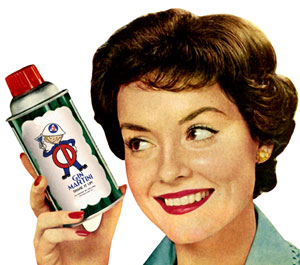 Dangerously, many shelter guides recommended alcohol-fueled stoves to heat food. It was the wrong kind of alcohol, but dad might be desperate enough to risk blindness, once his attempts to ferment the family’s limited supply of canned fruit failed.
Dangerously, many shelter guides recommended alcohol-fueled stoves to heat food. It was the wrong kind of alcohol, but dad might be desperate enough to risk blindness, once his attempts to ferment the family’s limited supply of canned fruit failed.
Soviet civil defense plans, on the other hand, weren’t so prudish, as evidenced by the suggestion that whatever vodka might be on hand could be diluted and used to treat radiation burns.
Some shelterees plainly meant to meet the apocalypse with aplomb. In their Oct. 20 1961 edition, Time magazine reported that one Jacksonville, FL millionaire “has a blast cellar equipped with an elevator, a pool table and a keg of wine.” One enterprising company sold a $400 shelter survival kit containing, among other sundries, a case of Scotch, six cases of beer “for uninvited guests,” and six bottles of champagne “for the all clear signal.”
Some “moles,” as they were disparagingly called, threw “shelter-warming” parties, showing them off in much the same way they’d show off a new boat or deck (a popular cocktail napkin of the day asked, “Your Bomb Shelter or Mine?”). Others, however, were a tad leery about letting their neighbors in on their elaborate preparations for doomsday.
Some cynics went so far as to suggest citizens with bomb shelters secretly wished there would be an atomic war. Which may have been true. If you plowed thousands of dollars into a first-class shelter (and were perhaps ridiculed by neighbors for doing so) the ultimate “I told you so” would be the wail of air raid sirens with the frantic back-beat of neighbors’ fists banging on your shelter’s reinforced steel door.
As happened in a 1961 episode of the Twilight Zone (The Shelter). After a wine-fueled party is soured by Conelrad announcing nuclear missiles were bearing down, the host herds his family into their much-mocked shelter and bolts the door. The neighbors turn into a mindless howling mob (as they were apt to do in TZ episodes) and eventually resort to employing a battering ram.
 The Government Gets Real
The Government Gets Real
Despite the prohibitionist bent of most of their early literature, over time the OCD became more realistic about post-apocalyptic boozing, especially when they actually put their theories to practice. During one OCD experiment, a New Jersey couple, the Powners, volunteered to spend two weeks in a fallout shelter with their two small children. Prior to sealing them in the hole, the scientists conducting the study suggested that a bottle of whiskey “for the adults” be included in the Powner’s inventory. Calming the kids with booze would, of course, be immoral, so they also suggested tranquilizer pills for the children. According to official OCD notes, the bottle was put to good use during the more “stressful moments.”
It apparently wasn’t the first time public officials employed alcohol in their studies–in 1952, Rep. Edwin A. Hall (R-NY) claimed members of the Congressional Atomic Energy Committee “were drunk at the recent Nevada A-bomb tests.”
The 1953 Civil Defense film Preparing for Tomorrow suggested your basement bomb shelter could double as a wine cellar, and the CEO of one shelter construction company sagely suggested your shelter could be used in the meantime as a bar. This way, if doomsday came to pass, “Your liquor at the bar won’t go to waste, you’ll need it.”
In 1960 OCD scientists suggested in a memo, perhaps jokingly, that the ideal basement shelter would be constructed entirely out of cans of beer. The walls would be two cases thick, the ceiling four, and “by the time you drink your way out of the shelter, it should be safe to go outside.” And if it wasn’t, you probably wouldn’t care.
In 1963 Admiral Lewis Strauss, former chairman of the Atomic Energy Commission, proposed a “fallout formula” for the perfect martini. He claimed a bottle of vermouth had been lashed atop a sensor tower during a 1951 A-bomb test at the Eniwetock Atoll. The blast atomized the vermouth into the atmosphere and the admiral suggested the perfect martini could be achieved by holding a glass of gin outdoors for a few minutes, allowing the vermouth-laced fallout circling the globe to settle into the martini.
The Triumph of Apathy
After the Last Big Scare (the Cuban Missile Crisis in 1962), Americans become steadily more cynical about trying to survive an atomic war. The new hydrogen bomb seemed too big a bullet to duck, no matter how deep you dug your shelter. Add to that the newly prevalent idea that a large-scale nuclear exchange would result in a “nuclear winter” that would render the earth uninhabitable, and it seemed pointless to prepare, or even worry.
Over time, the Atomic Cocktail fell out of favor and disappeared from bars (UPI staff writer Dick West claimed they were banned because of the heavy “morning-after” fallout.) Family bomb shelters slowly filled with junk or became rec rooms, the once ubiquitous Fallout Shelter signs slowly rusted away, and the once jolting wail of emergency siren tests became a slightly irritating background noise.
The New Face of Doomsday
Of course, humanity isn’t happy unless there’s some sort of doomsday scenario lurking on the horizon. Contrary to all reason, the possibility of world destruction can serve to take the edge off less spectacular worries; with the end of the world at hand, average workaday stresses seem unimportant. Like soldiers on the eve of a great battle, it suddenly seems a good idea to squeeze in some fun, a final hurrah before the whole shebang goes up in flames.
Hence the Mayan calendar hoopla. Come Dec. 21 2012, I strongly suspect there will be many more people getting bombed at “Doomsday Parties” then hunkering down in underground bunkers.
Or you could do both. A group called the Vivos Shelter Network is in the process of building a network of underground shelters in time for the Mayan calendar countdown. The largest shelter, in rural Nebraska, will house 900 people and, along with a movie theater, hair salon and decontamination showers, the facility boasts a “fully-stocked wine cellar” and the availability of “spirits.”
I’m not certain what quality or quantity of wine and liquor the $25,000 membership fee gets you, but I’ll bet even the worst box wine and rotgut whiskey in the world will taste like Dom Pérignon and Johnnie Walker if all the suckers trapped outside are getting drowned by tsunamis, fried up by super volcanos then swallowed whole by earthquakes.

